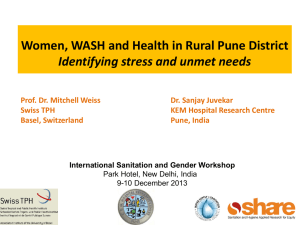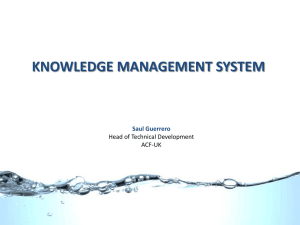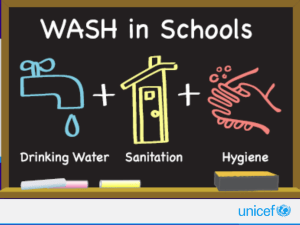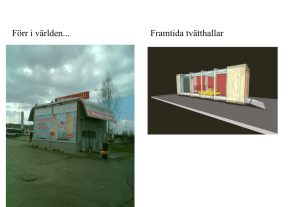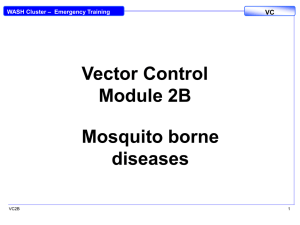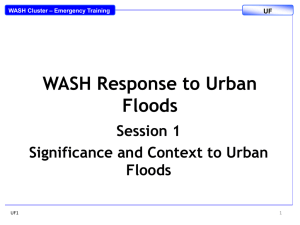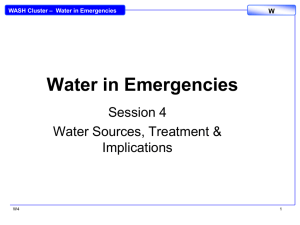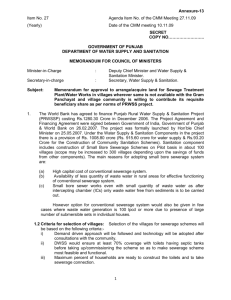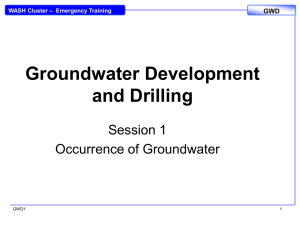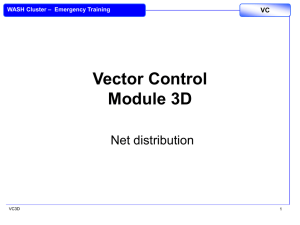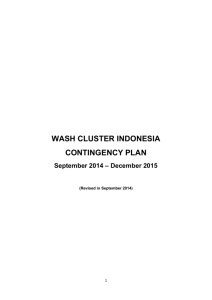E9_PP_Institutional sanitation
advertisement
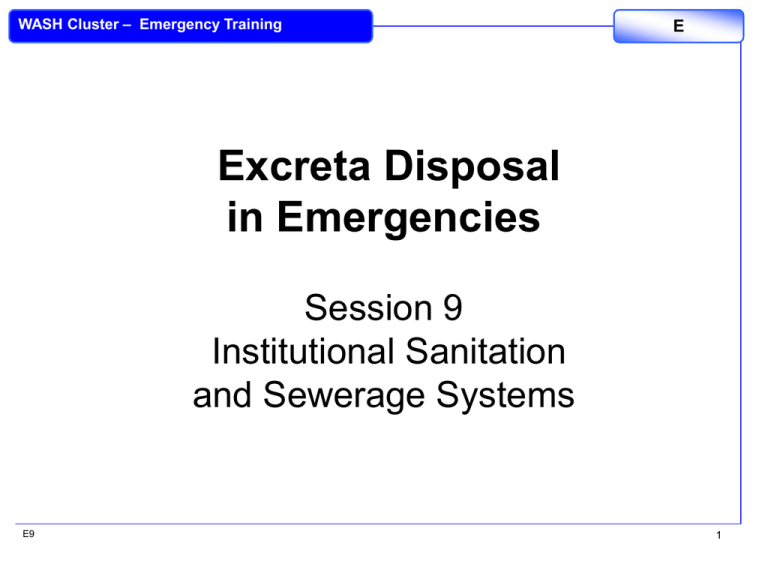
WASH Cluster – Emergency Training E Excreta Disposal in Emergencies Session 9 Institutional Sanitation and Sewerage Systems E9 1 WASH Cluster – Emergency Training E Institutional sanitation and sewerage systems Issues to consider when developing institutional sanitation: • Time constraints • Design life • Mandate of agency • Budget • Human resources • O&M E9 2 WASH Cluster – Emergency Training E Recommended Minimum Objectives: Ratios of toilets to people for Communal Latrine Use Setting E9 Immediate Short-term Long-term General Population Distance to walk (one way) 1:100 70m 1:50 50m 1:20 25m Medical Centres 1:50 beds 1:100 outpatients 1:20 beds 1:10 beds 1:50 outpatients 1:20 outpatients Schools 1:50 girls 1:100 boys 1:30 girls 1:60 boys 1:15 girls 1:30 boys Market areas 1:100 stalls 1:50 stalls 1:20 stalls Feeding Centres 1:100 adults 1:50 children 1:50 adults 1:20 children 1:20 adults 1:10 children 3 WASH Cluster – Emergency Training E Sanitation for schools • Separate for girls and boys • A higher ratio needed for under 5s • Girls over 11 need greater privacy and a private washing area • Fewer toilets needed for boys if also provided urinals (1 space per 40 A children’s pit latrine built by users) MSF in a refugee camp in Burundi, 1993. Photo courtesy K. Gibbs, RedR. E9 4 WASH Cluster – Emergency Training E Sanitation for schools Toilets should be: • As close as possible to the school, whilst still being environmentally safe (and down-wind) • Separate for girls & boys • Child friendly – light, small holes, supports • Kept clean – could arrange within the school • Provide water / handwashing facilities E9 5 WASH Cluster – Emergency Training E Sanitation for hospitals and clinics The highest possible hygiene standards are needed, as: • More infections are around • Higher number of pathogens in excreta • Greater infirmity, weakness and vulnerability to disease of the users Hospital Commode Chair Photo: Harvey, EDIE Manual. E9 6 WASH Cluster – Emergency Training E Sanitation for hospitals and clinics Communal blocks • Needs high ratio of toilets to users • Full-time attendants to maintain cleanliness • Strict handwashing regime with soap • Extra large space inside cubicle for helper if needed • Ramps for easy access • Supports/handles/commode seats for infirm E9 7 WASH Cluster – Emergency Training E Sewerage systems in emergencies If an urban sewerage system is undamaged, or needs only minor repairs, and If there are sufficient volumes of grey water still being generated to flush the sewers, and If the technical personnel and resources are available to maintain the sewage treatment works, Then the sewerage system may still be used. E9 8 WASH Cluster – Emergency Training E Immediate sewer use Temporary toilets may be built over existing sewers Needs 20-40 lpd water for flushing to prevent blockages Image courtesy of WEDC. (c) Ken Chatterton. E9 9 WASH Cluster – Emergency Training E Rehabilitation of sewerage systems • Assess the damage – plant, equipment, staff • Assess the risk for prioritisation of interventions • Immediate alternatives to sewers eg chemical toilets temporary toilets over sewers alternative drainage routes such as to septic tanks/cess pits E9 10 WASH Cluster – Emergency Training E Case study: rehabilitation of sewerage systems Basrah, Iraq – a city of 2 million • Pumping stations had stopped working after the Gulf War, 1995 • ICRC installed 18 pumping stations and 6 back-up generators to ensure continuous pumping • A complex system requiring qualified technicians E9 11
